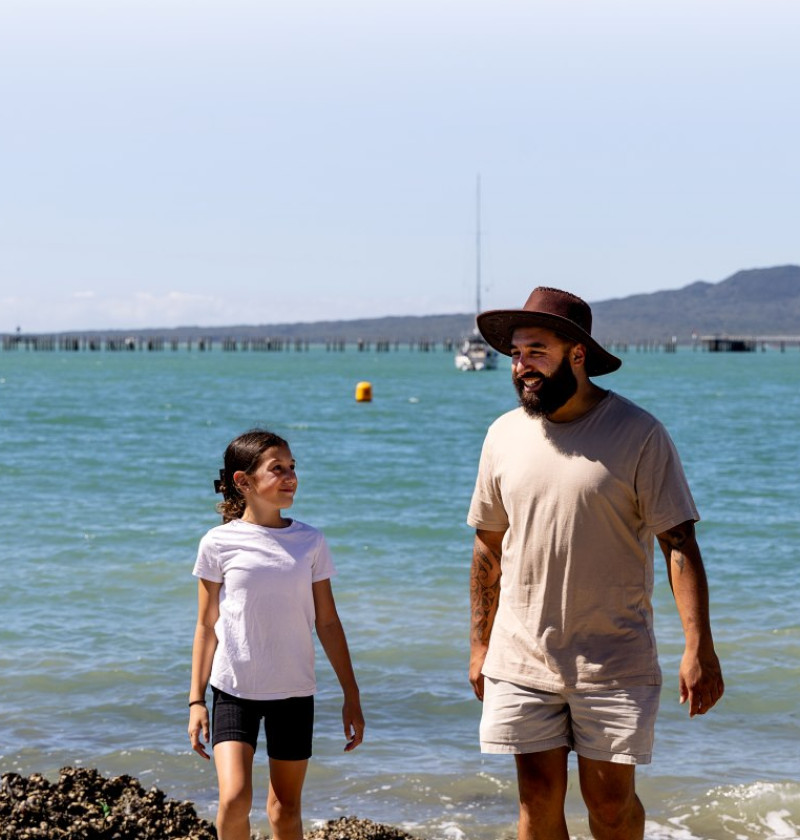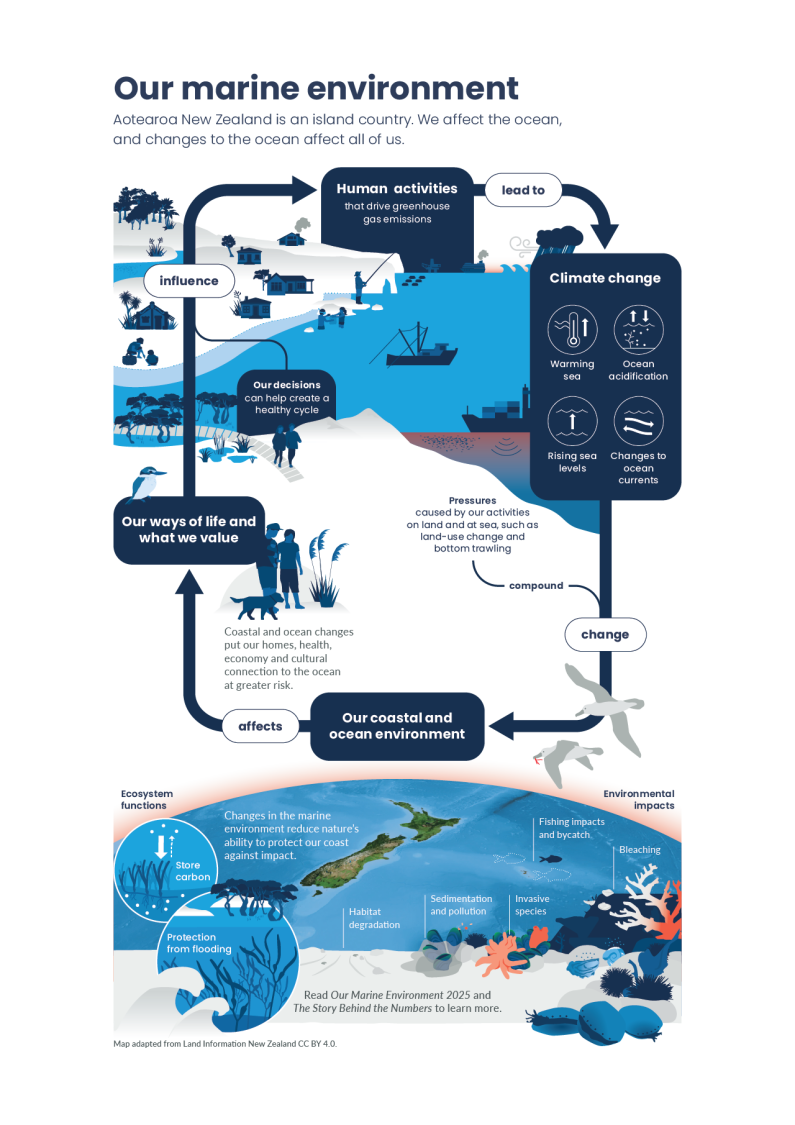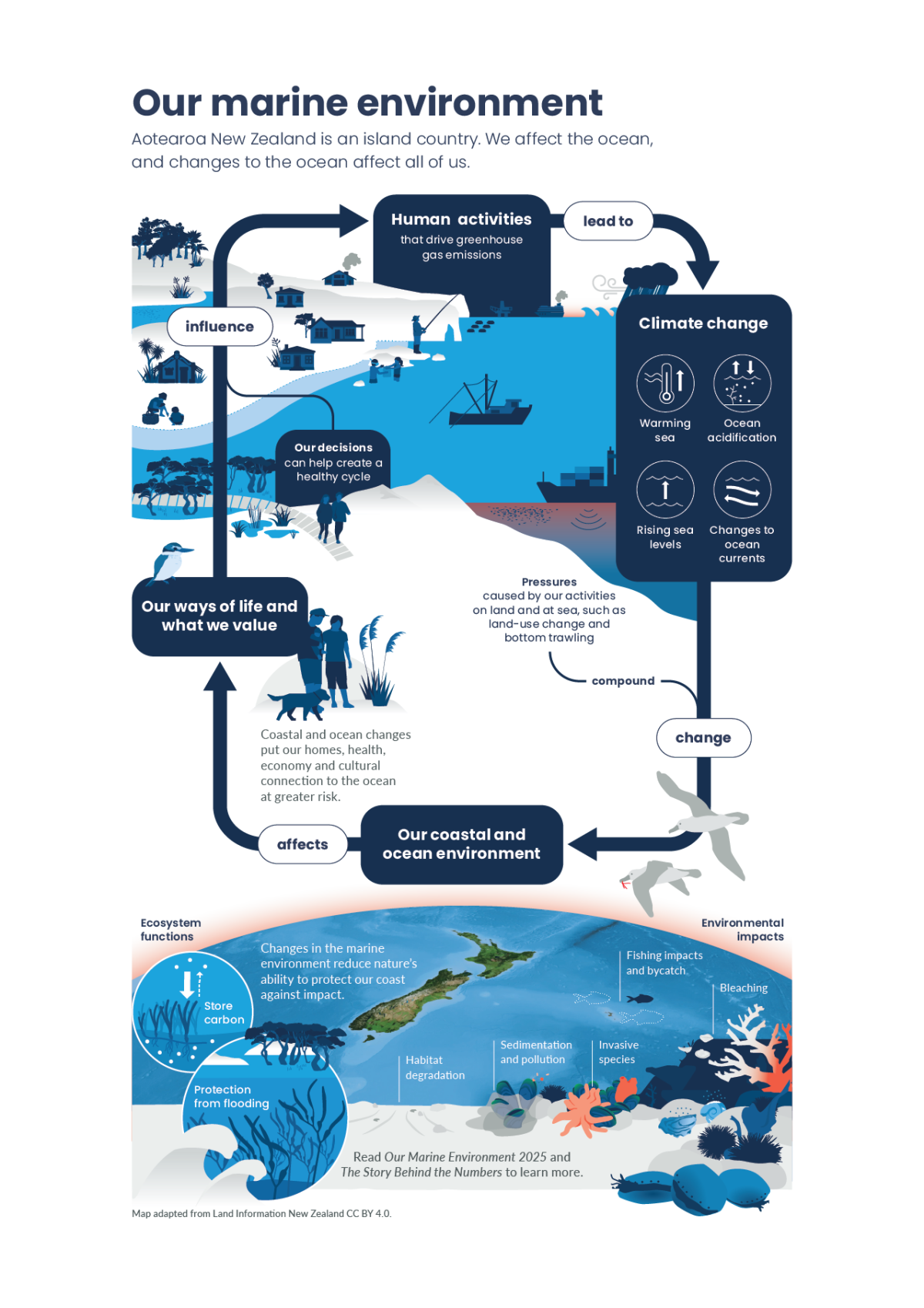Our Marine Environment 2025 Tō Tātou Taiao Moana

Our Marine Environment 2025 examines the most pressing issues in our oceans, seas, coastlines and estuaries, with a focus on the role of climate change in marine environments.
The report is produced jointly by the Ministry for the Environment and Stats NZ.
Our Marine Environment 2025 examines the most pressing issues in our oceans, seas, coastlines and estuaries, with a focus on the role of climate change in marine environments.
The report is produced jointly by the Ministry for the Environment and Stats NZ.
Tēnā koutou katoa
Aotearoa New Zealand’s position as an island nation shapes many aspects of our environment and our way of life. This geographic isolation has given rise to our unique flora and fauna, and our famously changeable weather is driven by the ocean that surrounds us. Our history, culture and identity are deeply intertwined with the marine environment and the isolation and protection it offers us.
The coast and ocean provide us with sustenance, recreation and economic opportunities. They also connect us to the rest of the world. But things are changing. Global climate disruption, resulting from humanity’s greenhouse gas emissions, is reshaping oceanic processes. Increasing sea temperature and acidity, decreasing oxygen levels and changes to ocean currents affect us here in New Zealand.
As a result, our native species and ecosystems are increasingly under threat. Warming waters bring more invasive species, while rising sea levels and more intense storms reshape our coasts. These changes have profound impacts, not only on biodiversity and natural habitats, but also on people and communities. Our marine economy, the natural infrastructure that protects our coastlines and the deep cultural connections that tie us to these environments are all at risk.
While we know more than ever about pressures on our marine environment, significant blind spots remain. Filling these gaps is essential to reduce risk, support a sustainable marine economy and strengthen climate resilience. Expanding our knowledge is also essential if we are to build our nation’s resilience and prepare for the changes to come. Our Marine Environment 2025 brings together the most recent available data and insights to help New Zealanders understand the impacts of climate change on our coasts and ocean.
This report is part of a series produced in partnership with Stats NZ. Our teams of analysts and scientists work independently of the government to organise this evidence and provide New Zealand with a benchmark for reporting that is factual, reliable and robust.
This information enables better decisions as communities work together to build our nation’s resilience and to hold on to the economic, cultural and environmental benefits we gain from our marine environment.
| James Palmer Secretary for the Environment |
Mary Craig Acting Government Statistician |
Aotearoa New Zealand has more than 15,000 kilometres of varied coastline – as an island nation, we are never far away from the coast. For many of us, our connections to beaches and the ocean are fundamental to who we are as New Zealanders.
The ocean and coasts of New Zealand are more than part of our identity – they support the homes, livelihoods and cultural practices of communities across the country. For Māori, the moana (ocean) is a taonga, central to whakapapa (ancestral ties) and tikanga (customs and protocols), and it has long been a pathway of connection across Te Moananui-a-Kiwa (the Pacific Ocean). Whether we are gathering kaimoana (seafood), surfing or simply walking along the beach, the marine environment shapes our way of life and anchors us.
New Zealand’s marine and coastal environments also play vital roles in supporting our economy. Industries such as aquaculture rely on clean, healthy waters to sustainably farm species such as mussels, oysters and salmon. Coastal tourism attracts both domestic and international visitors to experience our beaches, marine wildlife and water-based recreation.
Human activities both on land and at sea continue to place pressure on the marine environment. Land-based impacts such as pollution, sedimentation, coastal habitat squeeze and nutrient run-off degrade coastal and marine ecosystems. Ocean-based activities like bycatch, bottom trawling and overfishing further threaten biodiversity and ecological resilience. Many of these pressures interact with and are compounded by human-driven changes in the climate.
The burning of fossil fuels, land-use change and industrial processes have all contributed to an increase in greenhouse gas concentrations in the atmosphere. This increase is warming the planet and altering the global climate system, with intersecting consequences for the world’s oceans. Rising sea temperatures, ocean acidification, disrupted currents, and changing frequency and severity of extreme events are all symptoms of a climate system under pressure that is reshaping New Zealand’s marine environments.
Our Marine Environment 2025 – the latest report in our three-yearly updates on the state of our coasts and ocean – focuses on the impacts of climate change on global oceans, and the consequences for New Zealand’s coasts, marine ecosystems and communities. Previous reports have explored broader human and ecological systems in more detail, with the latest information available in Our environment 2025 and Our marine environment 2022.
Our actions have significant consequences for the marine environment, which shows that we also have control over decisions that can improve environmental outcomes for both ecosystems and people. For examples of how people are adapting to changes in marine and coastal environments, see Our Marine Environment: The Stories Behind the Numbers.
The global climate shapes the condition of New Zealand’s marine environment. Oceans absorb approximately 25 percent of global carbon dioxide emissions and more than 90 percent of the excess heat generated by those emissions, making them critical in stabilising Earth’s climate (UN, nd). However, absorbing all this heat and carbon dioxide makes the ocean warmer and more acidic, and the impacts of this are felt across New Zealand’s marine ecosystems. Climate change is altering where species are able to live, disrupting food webs and increasing the vulnerability of habitats such as kelp forests, shellfish beds and coral communities, with some regions experiencing more severe changes than others. The ocean around New Zealand is also warming faster than the global average, with more intense, longer and more frequent marine heatwaves.
Sea levels are rising, driven by water expanding as it warms along with melting polar and glacial ice. Vertical land movements are also a factor in some areas. Sea-level rise is already affecting low-lying coastal areas, increasing the frequency and severity of coastal flooding and erosion. These changes pose growing risks to infrastructure, housing, livelihoods and culturally significant sites. Shifts in ocean currents and temperature are beginning to influence marine plants and animals. This affects our unique native species and key commercial fish stocks, with implications for fisheries management and food security.
New Zealand’s isolation does not shield us from the far-reaching effects of global climate change. Instead, the changes to our oceans highlight the importance of understanding how climate, ocean health and human health are connected.
New Zealand’s coastlines and ocean are vital natural assets that protect and sustain our communities. Coastal wetlands and estuaries provide critical habitat for plants, insects, fish and shellfish, supporting biodiversity. They also act as natural buffers against coastal flooding, storms, wave inundation and erosion – reducing the impact of extreme weather events, storm surges and tsunamis. These natural features can function as protective infrastructure, reducing exposure to some climate-related hazards.
Beyond providing physical protection against the effects of climate change, marine ecosystems can help to maintain a stable climate by storing carbon in living organisms and sediments. Phytoplankton, kelp forests, seagrass meadows, saltmarsh, sediments and mangroves all play a role in capturing or storing carbon, helping to slow the increase of atmospheric greenhouse gas concentrations.
These ecosystems support New Zealand’s marine economy – providing the foundation for fisheries, aquaculture, transport, energy and tourism – and they contribute to cultural and recreational wellbeing.
Understanding the full value of these natural systems helps us appreciate how closely environmental health is tied to social and economic resilience. As climate pressures intensify, recognising the role of coastal and marine ecosystems in supporting life and livelihoods will help us to respond effectively.
Our Marine Environment 2025 is the latest in a series of environmental reports produced by the Ministry for the Environment and Stats NZ. It is the fourth report in the series dedicated to the marine environment, following the 2016, 2019 and 2022 reports, and is part of the fourth cycle of reports released under the Environmental Reporting Act 2015.
Evaluating specific policies and advice on responses to environmental issues is out of scope for environmental reports under the Environmental Reporting Act 2015, so these are not discussed in this report.
The indicator data used in this report came from many sources, including public research organisations and central and local government. Further supporting information was provided using a ‘body of evidence’ approach, which draws on and integrates findings from multiple sources to produce conclusions that are more robust and reliable than those based on a single study. This body of evidence includes peer-reviewed, published literature, grey literature such as government reports, and mātauranga Māori (Māori knowledge) and observational tools used to identify changes in the ecosystem.
All data used in this report, including references to scientific literature, were corroborated, and checked for consistency with the original source. The report was reviewed by a panel of independent scientists. The indicators related to the marine environment and the date they were last updated are available on the Stats NZ indicators web pages. Reports released under the Environmental Reporting Act 2015 are produced independently of government ministers.
This report’s focus is on how climate change drives change in our marine and coastal environments, and how these changes in turn affect people. It begins with the changes to global climate and ocean systems, then explains what this means for New Zealand’s environment, and ends with impacts for all of us.
Section 1 explores the role and impacts of the ocean in relation to our rapidly changing climate. It outlines the large-scale drivers of change, including rising sea temperatures, ocean acidification, decreasing oxygen levels and changes in ocean currents. These global processes set the stage for the changes we observe closer to home.
Section 2 moves the focus to New Zealand’s coasts. It examines how global ocean changes manifest in our marine and coastal environments – including through shifts in sea level, storm patterns, ocean chemistry and marine ecosystems. This section highlights the physical and ecological consequences of a changing ocean for our coastal waters, habitats and species.
Section 3 turns to people, exploring how changes in our marine and coastal environments affect communities, economies and cultural connections. This includes effects on coastal infrastructure, fisheries and customary practices, and on the wellbeing of people who live near or depend on the marine environment.
Section 4 outlines knowledge gaps and areas where more data, research and monitoring are needed to better understand the links between climate change and changes to the marine environment.

Our marine environment.
Aotearoa New Zealand is an island country. We affect the ocean, and changes to the ocean affect all of us.
The graphic depicts a cycle showing the interactions between our decisions and the marine environment. Our activities can drive changes to the ocean, and changes in the ocean will affect us.
Human activities that drive greenhouse gas emissions lead to climate change which results in warming seas, ocean acidification and rising sea levels.
Pressures caused by our activities on land and at sea, such as land-use change and bottom trawling, compound with pressures from climate change.
This changes our coastal and ocean environment, causing a series of environmental impacts, such as degradation to habitats, pollution and sedimentation. This also reduces nature’s ability to protect the ocean and coastal environment.
These changes affect our ways of life and what we value.
We can turn this cycle into a healthy one by influencing our activities with informed decisions.

Our marine environment.
Aotearoa New Zealand is an island country. We affect the ocean, and changes to the ocean affect all of us.
The graphic depicts a cycle showing the interactions between our decisions and the marine environment. Our activities can drive changes to the ocean, and changes in the ocean will affect us.
Human activities that drive greenhouse gas emissions lead to climate change which results in warming seas, ocean acidification and rising sea levels.
Pressures caused by our activities on land and at sea, such as land-use change and bottom trawling, compound with pressures from climate change.
This changes our coastal and ocean environment, causing a series of environmental impacts, such as degradation to habitats, pollution and sedimentation. This also reduces nature’s ability to protect the ocean and coastal environment.
These changes affect our ways of life and what we value.
We can turn this cycle into a healthy one by influencing our activities with informed decisions.
We have updated a link to an old indicator to the live one at publication and corrected misnaming an invasive sea squirt as a fanworm.
On page 14, the link to the Coastal sea-level rise indicator has been updated from the old indicator link https://www.stats.govt.nz/indicators/coastal-sea-level-rise-published-october-2019/ to the version current at release https://www.stats.govt.nz/indicators/coastal-sea-level-rise/.
On page 41, the sentence “Direct economic losses from two invasive fanworm species (Sabella spallanzanii and Styela clava) on green-lipped mussel aquaculture are estimated to be $26.4 million over a 24-year period.”, has been corrected to “Direct economic losses from two invasive species, the Mediterranean tubeworm (Sabella spallanzanii) and the clubbed tunicate (Styela clava), on green-lipped mussel aquaculture are estimated to be $26.4 million over a 24-year period.”

Our Marine Environment 2025 Tō Tātou Taiao Moana
October 2025
© Ministry for the Environment